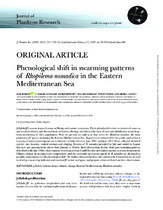| dc.description.abstract | Jellyfish (JF) swarms impact human wellbeing and marine ecosystems. Their global proliferation is a matter of concern and scientific debate, and the multitude of factors affecting (and affected by) their density and distribution merits long-term monitoring of their populations. Here we present an eight-year time series for Rhopilema nomadica, the most prominent JF species swarming the Eastern Mediterranean Sea. Reports were submitted by the public and within it a group of trained participants via an internet website between June 2011 and June 2019. Data collected included species, size, location, ranked amount and stinging. Swarms of R. nomadica prevailed in July and ended in August but were also prominent in winter from January to March. Both observations deviate from past swarming patterns described in the late 1980s, when summer swarms persevered until October and winter swarms were not documented. Climate change (increasing water temperature) and the westwards up-current spread of R. nomadica are discussed as possible explanations for this phenological shift. | en_US |

